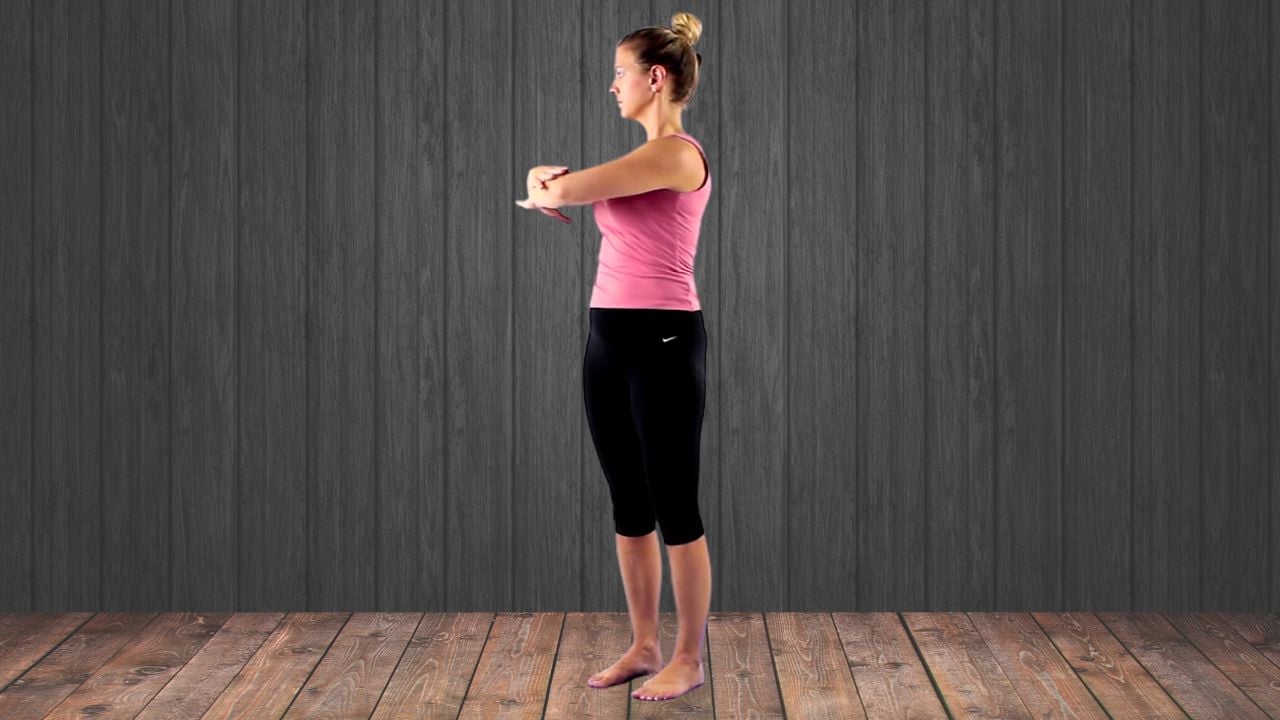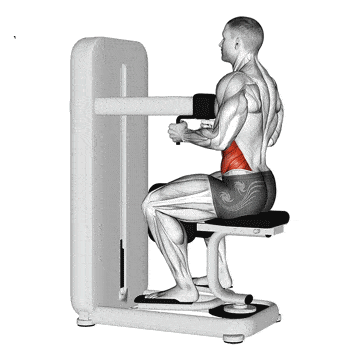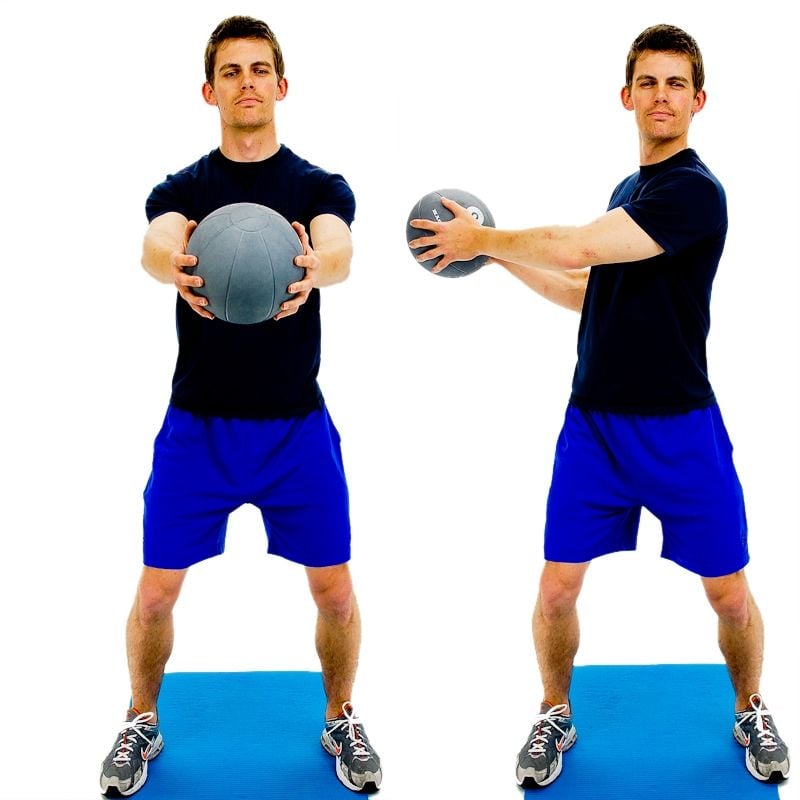Standing Oblique Twist, also known as standing twist or side twist, is a simple yet effective exercise that targets the oblique muscles (the sides of your abdominal wall).
The twisting motion of this exercise is a great way to engage and strengthen your core muscles. It also helps to improve spine mobility.
Interestingly, research shows that during twisting movements, different core muscles activate uniquely depending on your body position (sitting or standing), effort level, and whether you use resistance.
For example, twisting with added resistance (like a medicine ball or cable) activates the muscles more deeply—especially on the side you’re turning toward—while free twisting activates them less but still supports spinal movement and coordination.
It’s a simple exercise you can do with or without weights. When done properly, it supports both core strength and healthy, mobile movement through the spine.
Know More Body Fat %: Use Our Free Body Fat Calculator

- Oblique Twists Muscles Worked
- How To Do Standing Oblique Twist
- Tips for Proper Form
- Benefits of Oblique Twists
- Standing Oblique Twist Variations and Modifications
- 1. Standing Plate Twist
- 2. Standing Barbell Twist
- 3. Machine Oblique Twist
- 4. Standing Cable Oblique Twist
- 5. Standing Dumbbell Twist
- 6. Resistance Band Oblique Twist
- 7. Standing Oblique Twists with Medicine Ball
Oblique Twists Muscles Worked

Your abs consist of three major muscles: the rectus abdominis, the obliques, and the transverse abdominis.
- The primary muscle worked during standing oblique twists is the oblique.
- Secondary muscles worked are serratus muscles, Gluteus Medius, Gluteus Minimus, Psoas Major, and abs
How To Do Standing Oblique Twist
- Stand tall with your feet about shoulder-width apart, maybe slightly wider.
- Keep a soft bend in your knees—never lock out. Engage your glutes slightly for stability.
- Clasp your hands together in front of your chest or place them behind your head or on the side.
- Brace your core and rotate your torso (ribcage and shoulders) to one side. Think about twisting around your spine.
- Keep your hips facing relatively forward. Some natural hip movement is okay, but avoid letting your hips slide.
- Twist as far as you comfortably can while maintaining control and good posture. Don’t force it into a painful range.
- Inhale as you smoothly and controllably rotate back to the starting position.
- Exhale on the turns, and inhale when coming back.
Note: Do 3–4 sets and 10–15 reps for each side. For best results, do this standing oblique workout after your regular strength or cardio session, up to 2–3 days a week.
Tips for Proper Form
- Avoid fast, jerky movements. The twist should be smooth and controlled.
- Keep your hips facing forward; they should not rotate with your upper body.
- Stand tall; do not hunch or crunch your shoulders. Keep your chest lifted and back straight, even while twisting.
- Coordinate your breathing with your movements — inhale at the center and exhale on the twist.
- Visualize your spine as a central axis and your torso rotating around it. The movement should primarily come from your mid-to-upper back (thoracic spine) and waist.
- Twist only as far as you can without straining. Overextending can cause back strain.
- Align your neck with your spine. Avoid craning your neck forward or twisting it to the sides excessively.
- Don’t just go through the motions. Actively think about the muscle you’re trying to work. Feel it contract when rotating.
- If you’re placing your hands behind your head, keep your elbows wide and avoid pulling on your neck.
Know More: 100+ Ways To Lose Weight (Proven Techniques)
Benefits of Oblique Twists
- Strengthening your oblique muscles with a twisting motion helps build muscular endurance and power.
- As you continue practising controlled twists, your trunk rotation’s mobility will improve, which is helpful for sports and everyday movement.
- Strong obliques stabilize your core, alleviating strain on your lower back and preventing injury or pain.
- This can contribute to burning calories and potentially reducing waist circumference.
- It increases your core speed and improves your performance when participating in sports such as football, netball, golf, etc.
- The standing twist is a rotational movement that requires whole-body coordination, which improves balance in fitness and daily life.
- As a bodyweight exercise, you can do it anywhere without equipment. Try the exercises below at home, in your hotel room, or at the gym—no lying on dirty floors is required.
- This twist is easy for beginners, while more advanced exercisers can progress over time with added resistance or reps.
Standing Oblique Twist Variations and Modifications
Standing oblique twist exercises come in different varieties. Oblique twists are versatile and easy to perform. In fact, there is no one way to perform an oblique twist.
Each oblique twist is unique and will keep any workout routine interesting.
You can easily and effectively do the standing oblique Twist with a Plate, Barbell, Machine, and Cable.
1. Standing Plate Twist
Standing Plate Twist (aka Torso Rotation) is best used to warm up the oblique abdominal muscles and mobilize the torso.
It’s important to know that this exercise won’t make your waist smaller, as this myth is pretty popular. When you become lean, however, the exercise can help to make that area look a bit more toned.
How To Do
- Hold the plate (weight) with both hands and stand with your feet hip-width apart.
- Keep your arms to your chest, then, using your abs, twist your torso as you bring your arms to the left side of your body, then the right.
- Keep your body still during the motion; only your torso moves.
- Make sure to get a full range of motion, twisting from one side to the other and then back again.
- Exhale on the turns, and inhale when coming back.
2. Standing Barbell Twist
Unlike bodyweight or light dumbbell twists, the barbell adds a long lever and external load, which more intensely challenges your obliques, erector spinae, and deep stabilizers.
If you’re already comfortable with bodyweight twists, adding a barbell is a safe way to build more strength.
It is a great idea to stop halfway through some reps and attempt to resist the twisting force. This will strengthen your torso’s ability to resist twisting forces.
How To Do
- Take a light barbell and rest it on your upper back. Make sure not to rest the weight on your neck.
- Stand up straight and with your feet on the floor at a wider than shoulder-width stance.
- Slowly twist your torso to the right and then to the left. Twist as far as possible.
- Try to keep your abs tight throughout the whole set.
3. Machine Oblique Twist
You can easily perform this standing Twist with a twisting machine. At the gym, abs machines make it easy to isolate your abs and hit them with different angles with targeted resistance.
It strengthens your core, so it may help you avoid back injury. A strong core is also important for physical strength and balance.

How To Do
- Stand on a twisting machine with feet and hips apart or seat hold on (depending on the machine type) and hold the machine handles.
- Assume a normal posture, with your back straight.
- Exhale and twist the pelvis slowly to your right, as far as possible.
- Hold the stretch for several seconds and return to your starting position while inhaling.
- Perform the stretch on the other side, this time turning to your left as far as you can.
4. Standing Cable Oblique Twist
The standing oblique cable twist is an isolation exercise that works the oblique muscles of the core.
It’s unique in that it helps to strengthen the core muscles and is a functional exercise because it is performed on the feet.

How To Do
- Attach a handle to a shoulder-height cable pulley.
- Grasp the handle with both hands, either with your fingers interlaced or with one hand over the other.
- Pull the handle, twisting across your body to your opposite side until your torso faces away from the pulley.
- Hold for a count of two. Then, slowly reverse the movement to return to the starting position.
- Do 10–12 reps. Repeat the exercise on your opposite side.
5. Standing Dumbbell Twist
The added dumbbell resistance increases oblique engagement, especially when you twist with deliberate form. It’s a great way to tone and strengthen the sides of your core.
During rotation, this will also help develop strength and flexibility in your hips and lower back.
It looks simple, but it’s a real challenge. If you are a beginner, keep a dumbbell close to the body, and to increase the difficulty, move it further away.
How To Do
- Hold a dumbbell with both hands and hold it vertically.
- With straight arms, raise the dumbbell in front of you, so it’s parallel to the floor.
- Contract your core and then twist to one side, just past your shoulders, without moving your lower body.
- Hold for a count of two. Then, slowly reverse the movement to return to the starting position.
- Repeat the desired number of times from both sides.
6. Resistance Band Oblique Twist
With just a durable resistance band, you can perform targeted abs exercises that tone your rectus abdominis and obliques.
It is a great exercise for full-body mobility and flexibility. Start with a band that offers light to moderate resistance.
If your muscles are not fatigued after several sets, you should consider increasing the resistance level.
How To Do
- The resistance band should be attached to a stable object at waist height.
- Stand a foot away and hold the ends of the bands with your hands.
- Stand with your arms stretched out in front of you.
- Pull the bands across your body, twisting as you pull.
- Hold for two seconds on the turn, and then return to your starting position.
- Do the 10–12 reps from each side.
Know More: 10 Best Resistance Band Abs Exercises (With Workout Plan)
7. Standing Oblique Twists with Medicine Ball
The medicine ball is a perfect addition to any gym workout. It is small and easy to use for a productive and fast workout.

How To Do
- Stand with your feet hip-width apart and your knees slightly bent.
- Hold a medicine ball in front of your chest with your arms bent.
- When looking straight ahead, contract the abdominal muscles and slowly turn the torso to the right.
- Then, slowly reverse the movement to return to the starting position.

Manish is a NASM-certified fitness and nutrition coach with over 10 years of experience in weight lifting and fat loss fitness coaching. He specializes in gym-based training and has a lot of knowledge about exercise, lifting technique, biomechanics, and more.
Through “Fit Life Regime,” he generously shares the insights he’s gained over a decade in the field. His goal is to equip others with the knowledge to start their own fitness journey.
